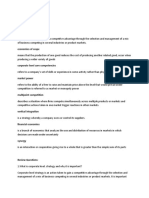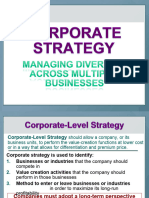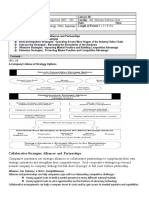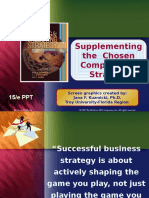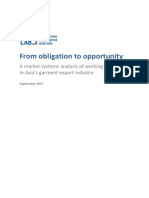2eIM LN Chapter6
2eIM LN Chapter6
Uploaded by
Resful Islam RazuCopyright:
Available Formats
2eIM LN Chapter6
2eIM LN Chapter6
Uploaded by
Resful Islam RazuCopyright
Available Formats
Share this document
Did you find this document useful?
Is this content inappropriate?
Copyright:
Available Formats
2eIM LN Chapter6
2eIM LN Chapter6
Uploaded by
Resful Islam RazuCopyright:
Available Formats
Section 6
Lecture Notes for Chapter 6
379
Chapter
Chapter Summary
Supplementing the Chosen Competitive Strategy Other Important Strategy Choices
Chapter Six identies that once a company has settled on which of the ve basic competitive strategies to employ, attention must turn to what other strategic actions can be taken in order to complement its competitive approach and round out its business strategy. As discussed in earlier chapters, a companys overall business strategy includes not only the details of its competitive strategy, but also other strategic initiatives that can promote competitive advantage. Several measures to enhance a companys strategy have to be considered: Whether to enter into strategic alliances or partnerships arrangements with other enterprises. Whether to bolster the companys market position via merger or acquisition. Whether to integrate backward or forward into more stages of the industry value chain. Which value chain activities, if any, should be outsourced. Whether and when to go on the offensive and initiate aggressive strategic moves to improve the companys market position. Whether and when to employ defensive strategies to protect the companys market porisiton. When to undertake strategic moveswhether it is advantageous to be a rst-mover or a fast follower or a late-mover. to expedite the development of promising new technologies or products, to overcome decits in their own technical and manufacturing expertise This chapter presents the pros and cons of each of these business strategy choices.
Lecture Outline
I. Strategic Alliances and Collaborative Partnerships 1. Companies in all types of industries and have elected to form strategic alliances and partnerships to add to their accumulation of resources and competitive capabilities and strengthen their competitiveness in domestic and international markets. 2. The most common reasons why companies enter into strategic alliances are: to expedite the development of promising new technologies or products, to overcome decits in their own technical and manufacturing expertise
379
380
Section 6
Instructors Manual for Essentials of Strategic Management
to bring together the personnel and expertise needed to create desirable new skill sets and capabilities, to improve supply chain efciencies, to gain economies of scale in production and/or marketing, and to acquire or improve market access through joint marketing agreements. Core Concept
Strategic alliances are collaborative arrangements where two or more companies join forces to achieve mutually benecial strategic outcomes. The competitive attraction of alliances is in allowing companies to bundle competencies and resources that are more valuable in a joint effort than when kept separate.
A. Failed Strategic Alliances and Cooperative Partnerships 1. Alliances are more likely to be long lasting when (a) they involve collaboration with suppliers or distribution allies, or (b) both parties conclude that continued collaboration is in their mutual interest, perhaps because new opportunities for learning are emerging. 2. A surprisingly large number of alliances never live up to expectations. An article (2007) from the Harvard Business Review reported that even though the number of alliances increases by about 25 percent annually, about 60 to 70 percent continue to fail each year. 3. Experience indicates that alliances stand a reasonable chance of helping a company reduce competitive disadvantage but rarely have they proved a durable competitive edge over rivals. B. The Strategic Dangers of Relying on Alliances for Essential Resources and Capabilities 1. The Achilles heel of alliances and cooperative strategies is dependence on another company for essential expertise and capabilities. II. Merger and Acquisition Strategies 1. Mergers and acquisitions are especially suited for situations where alliances or partnerships do not go far enough in providing a company with access to the needed resources and capabilities. Core Concept
Combining the operations of two companies, via merger or acquisition, is an attractive strategic option for achieving operating economies, strengthening the resulting companys competencies and competitiveness, and opening up avenues of new market opportunity.
2. A merger is the combining of two or more companies into a single entity. An acquisition is a combination in which one company, the acquirer, purchases and absorbs the operations of another, the acquired. 3. The difference between a merger and an acquisition relates more to the details of ownership, management control, and nancial arrangements than to strategy and competitive advantage. The resources, competencies, and competitive capabilities of the newly created enterprise end up much the same whether the combination is the result of acquisition or merger. 4. Many mergers and acquisitions are driven by strategies to achieve one of ve strategic objectives: To create a more cost-efcient operation out of the combined companies.
Section 6
Lecture Notes for Chapter 6
381
To expand a companys geographic coverage. To extend the companys business into new product categories or international markets. To gain quick access to new technologies or other resources and competitive capabilities. To try to invent a new industry and lead the convergence of industries whose boundaries are being blurred by changing technologies and new market opportunities. 5. Concepts & Connections 6.1 describe how Clear Channel Communications has used acquisitions to build a leading global position in outdoor advertising and radio broadcasting. C. Why Mergers and Acquisitions Sometimes Fail to Produce Anticipated Results 1. Cost savings may prove smaller than expected. 2. Gains in competitive capabilities may take substantially longer to realize, or worse, may never materialize at all. 3. Efforts to mesh the corporate cultures can stall out due to formidable resistance from organization members. 4. Managers and employees at the acquired company may argue forcefully for continuing to do certain things the way they were done prior to the acquisition. 5. Key employees at the acquired company can quickly become disenchanted and leave.
Illustration Capsule 6.1, Clear Channel CommunicationsUsing Mergers and Acquisitions to Become a Global Market Leader
Discussion Question: Discuss the impact that the loosening of rules by the FCC had on Clear Channels business strategy. Describe how acquisitions beneted this company. Answer: In the late 1980s, following the decision by the FCC to loosen rules regarding the ability of one company to own both radio and TV stations, Clear Channel broadened its strategy and began acquiring small, struggling TV stations. Its new strategy was to buy radio, TV, and outdoor advertising properties with operations in many of the same local markets, share facilities and staffs to cut costs, improve programming, and sell advertising for all three media simultaneously. By 1998, Clear Channel had used acquisitions to build a leading position in radio and television stations. In 2003, this company owned radio and television stations, outdoor advertising, and entertainment venues in 66 countries around the world.
III. Vertical Integration Strategies: Operating Across More Industry Value Chain Segments 1. Vertical integration strategies can aim at full integration or partial integration. Core Concept
A vertical integration strategy has appeal only if it signicantly strengthens a rms competitive position and/or boosts its protability.
382
Section 6
Instructors Manual for Essentials of Strategic Management
A. The Advantages of a Vertical Integration Strategy 1. The two best reasons for investing company resources in vertical integration are to strengthen the rms competitive position and/or boost its protability, 2. Integrating Backward to Achieve Greater Competitiveness: For backward integration to be a viable and protable strategy, a company must be able to 1) achieve the same scale economies as outside suppliers, and 2) match or beat suppliers production efciency with no drop-off in quality.
3. Backward integration is most likely to reduce costs when: a. Suppliers have very large prot margins b. The item being supplied is a major cost component c. The requisite technological skills are easily mastered or can be gained or acquired. 4. Backward vertical integration can produce a differentiation-based competitive advantage when performing activities internally contributes to a better quality product/service offering, improves the caliber of customer service, or in other ways enhances the performance of its nal product. 5. Integrating Forward to Enhance Competitiveness allows manufacturers to gain better access to end users, improve market visibility, and include the end users purchasing experience as a differentiating experience. 6. Forward vertical integration and internet retailing can have appeal if it lowers distribution costs, produces a relative cost advantage over certain rivals, offers higher margins, or results in lower selling prices to end users. B. The Disadvantages of a Vertical Integration Strategy 1. Vertical integration has some substantial drawbacks: It boosts a rms capital investment in the industry. Integrating into more industry value chain segments increases business risk if industry growth and protability sour. Vertically integrated companies are often slow to embrace technological advances or more efcient productions methods when they are saddled with older technology or facilities Integrating backward potentially results in less exibility in accommodating shifting buyer preferences when a new product design doesnt include parts and components that the company makes in-house. Vertical integration poses all kinds of capacity matching problems. Integrating across several production stages in ways that achieve the lowest feasible costs can be a monumental challenge. Integration forward or backward often requires the development of new skills and business capabilities.
Core Concept
In todays world of close relationships with suppliers and efcient supply chain management, very few businesses can make a case for integrating backward into the business of suppliers.
Section 6
Lecture Notes for Chapter 6
383
C. Outsourcing Strategies: Narrowing the Boundaries of the Business 1. Outsourcing makes sense whenever: An activity can be performed better or more cheaply by outside specialists. The activity is not crucial to the rms ability to achieve sustainable competitive advantage and wont hollow out its capabilities, core competencies, or technical know-how. It improves a companys ability to innovate. It allows a company to concentrate on its core business, leverage its key resources and core competencies, and do even better what it already does best. Core Concept
A company should generally not perform any value chain activity internally that can be performed more efciently or effectively by outsiderthe chief exception is when a particular activity is strategically crucial.
2. The risk of an outsourcing strategy is that a company will farm out the wrong types of activities and thereby hallow out its own capabilities. IV. Strategic Options to Improve a Companys Market Position the Use of Strategic Offences 1. There are times when a company should be aggressive and go on the offensive. Strategic offences are called for when a company spots opportunities to gain protable market share at the expense of rivals or when a company has no choice but to try to whittle away at a strong rivals competitive advantage. A. Choosing the Basis for Competitive Attack 1. As a general rule, strategic offenses should be grounded in a companys competitive assets and strong points, and exploit competitor weaknesses. 2. The principal offensive strategy options include the following: a. Attacking the competitive weaknesses of rivals. b. Offering an equally good or better product at a lower price c. Pursuing continuous product innovation to draw sales and market share away from less innovative rivals. d. Leapfrogging competitors by being the rst to market the next generation technology or products. e. Adopting and improving on the good ideas of other companies (rivals or otherwise). f. Deliberately attacking those market segments where a key rival makes big prots.
g. Maneuvering around competitors to capture unoccupied or less contested market territory. h. Using hit-and run guerrilla warfare tactics to grab sales and market share from complacent or distracted rivals. i. Launching a preemptive strike to capture a rare opportunity or secure an industrys limited resources.
384
Section 6
Instructors Manual for Essentials of Strategic Management
B. Choosing Which Rivals to Attack 1. Offensive-minded rms need to analyze which of their rivals to challenge as well as how to mount that challenge. The following are the best targets for offensive attacks: Market leaders that are vulnerable Runner-up rms with weaknesses in areas where the challenger is strong Struggling enterprises that are on the verge of going under Small local and regional rms with limited capabilities C. Blue Ocean Strategy -- A Special Kind of Offensive 1. A blue ocean strategy seeks to gain a dramatic and durable competitive advantage by abandoning efforts to beat out competitors in existing markets and, instead, inventing a new industry or distinctive market segment that renders existing competitors largely irrelevant and allows a company to create and capture altogether new demand. 2. This strategy views the business universe as consisting of two distinct types of market space: a. Industry boundaries are dened and accepted, the competitive rules of the game are well understood by all industry members, and companies try to outperform rivals by capturing a bigger share of existing demand. In such markets lively competition constrains a companys prospects for rapid growth and superior protability since rivals move quickly to imitate or counter the successes of competitors. b. Industry does not really exist yet, is untainted by competition, and offers wide open opportunity for protable and rapid growth if a company can come up with a product offering and strategy that allows it to create new demand rather than ght over existing demand. Examples include Cirque du Soleil, which re-invented the circus, and eBay. V. Strategy Options to Protect a Companys Market Position and Competitive Advantage The Use of Defensive Strategies 1. In a competitive market, all rms are subject to offensive challenges from rivals. The purposes of defensive strategies are to lower the risk of being attacked, weaken the impact of any attack that occurs, and inuence challengers to aim their efforts at other rivals. Core Concept
Great defensive strategies can help protect competitive advantage but rarely are the basis for creating it.
A. Blocking the Avenues Open to Challengers 1. There are any number of obstacles that can be put in the path of would-be challengers. 2. A defender can introduce new features, add new model, or broaden its product line to close off vacant niches to opportunity-seeking challengers. 3. It can try to discourage buyers from trying competitors brands. 4. A defender can grant volume discounts or better nancing terms to discourage experimenting with other suppliers.
Section 6
Lecture Notes for Chapter 6
385
B. Signaling Challengers that Retaliation is Likely Publicly announcing managements commitment to maintain the rms present market share. Publicly committing the company to a policy of matching competitors terms or prices. Maintaining a war chest of cash and marketable securities. Making an occasional strong counter-response to the moves of weak competitors to enhance the rms image as a tough defender. VI. Timing a Companys Strategic Moves 1. Timing is especially important when rst-mover advantages or disadvantages exist. 2. Sometimes markets are slow to accept the innovative product offering of a rst-mover, in which case a fast follower with substantial resources and marketing muscle can overtake a rst mover. 3. To sustain any advantage that may initially accrue to a pioneer, a rst-mover needs to be a fast learner sand continue to move aggressively to capitalize on any initial pioneering advantage. Core Concept
Because of rst-mover advantages and disadvantages, competitive advantage can spring from when a move is made as well as from what move is made.
A. The Potential For Late-Mover Advantages or First-Mover Disadvantages 1. When pioneering leadership is more costly than imitating followership and only negligible learning/experience curve benets accrue to the leadera condition that allows a to end up with lower costs than the rst-mover. 2. When the products of an innovator are somewhat primitive and do not live up to buyer expectations, thus allowing a clever follower to win disenchanted buyers away from the leader with better-performing products. 3. When the demand side of the marketplace is skeptical about the benets of a new technology or product being pioneered by a rst-mover. 4. When rapid market evolution (due to fast paced changes in either technology or buyer needs and expectations) gives fast-followers and maybe even cautious late-movers the opening to leapfrog a rst-movers products with more attractive next version products. 5. Concepts & Connections 6.2 describes how amazon.com achieved a rst-mover advantage in online retailing.
Illustration Capsule 6.2, Amazon.Coms First-Mover Advantage in Online Retailing
Discussion Question: Jeff Bezos, Founder and CEO of Amazon.com can be credited with rst-mover advantage in several instances of Amazon.coms amazing growth. Discuss.
386
Section 6
Instructors Manual for Essentials of Strategic Management
B. Deciding Whether to Be an Early-Mover or Late Mover 1. In weighing the pros and cons of being a rst-mover versus a fast follower versus a slow mover, it matters whether the race to market leadership in a particular industry is a marathon or a spring. 2. Any company that seeks competitive advantage by being a rst-mover needs to ask some hard questions. Does market take-off depend on the development of complementary products or services that are currently not available? Is new infrastructure required before buyer demand can surge? Will buyers need to learn new skills or adopt new behaviors? Will buyers encounter higher switching costs? Are there inuential competitors in a position to delay or derail the efforts of a rst mover? 3. When the answer to any of the questions are yes, then a company must be careful not to pour too many resources into getting ahead of the market opportunitythe race is likely going to be more of a 10-year marathon than a two-year sprint.
Assurance of Learning Exercises
1. Using your university librarys subscription to Lexis-Nexis, EBSCO, or a similar database, perform a search on acquisition strategy. Identify at least two companies in different industries that are using acquisitions to strengthen their market positions. How have these acquisitions enhanced the acquiring companies resource strengths and competitive capabilities? The vast amount of choices should permit students to offer extensive, well-developed answers to this question. Suggested student responses may identify the following examples. The rst example is SCM Microsystems, Inc.s merger with Hirsch Electronics Corporation. Following the merger, revenue more than doubled, reecting the success of the Companys strategy to increase its revenue by expanding its customer base and market reach through acquisitions and market investment. According to Felix Marx, chief executive ofcer of SCM Microsystems, The integration of Hirsch and SCM has proceeded rapidly as we have focused on creating synergies within our sales and marketing organizations to accelerate the acquisition of new customers, expand our mutual distribution channels and introduce new products in target markets. A second example is Nucor Corporations acquisition of Harris Steel. This acquisition was based on Nucors desire to achieve vertical integration both upstream for lower cost raw materials and downstream for a higher valueadded product mix and diversication. 2. Go to www.bridgestone.co.jp/english/info and review information about Bridgestone Corporations Tire and Raw Materials operations under the Corporate Information and Data Library links. To what extent is the company vertically integrated? What segments of the industry value chain has the company chosen to perform? What are the benets and liabilities of Bridgestones vertical integration strategy? NOTE: Entering the above link will take students to www.bridgestone.com. After reviewing the Web site, information related to the companys vertical integration strategy can be found in the following areas. (1) Click on Corporate, click on Prole, click on Total Optimization and (2) Click on Responsibilities, click on Programs.
Section 6
Lecture Notes for Chapter 6
387
Bridgestone Tire Co., Ltd. was established in 1931. As Japans automobile industry grew, The Bridgestone Group expanded to become Japans largest tire manufacturer. The company also actively expanded overseas, particularly in Asia. In 1988, the company acquired The Firestone Tire & Rubber Company, a global corporation, and this transformed Bridgestone into one of the worlds largest tire and rubber companies. Based on the information provided, the company is denitely vertically integrated to include development, manufacturing, marketing, and distribution of tires. The companys operations include, Tires and tubes for passenger cars, trucks and buses, construction and mining vehicles, industrial machinery, agricultural machinery, aircrafts, motorcycles and scooters, and other automotive parts, retreading materials and services, automotive maintenance and repair services, raw materials for tires, and other products. The Bridgestone Group currently operates 179 production facilities located in 25 countries. The company sells products in more than 150 countries around the world. The sales network is one of the largest in the world. The company strives to provide direct, personalized sales and technical service to customers across the globe. The segments of the industry value chain the company performs is best summarized as follows, Bridgestone Group operations span upstream and downstream activities, committing us to the deployment of extensive resources on a global basis to build a business that stretches from sourcing of raw materials to the sale of nal products. The effective and efcient management of these resources enables us to develop products and supply services which are highly competitive in the global marketplace and provide our customers with the quality that they have come to expect from Bridgestone. According to the company, a key issue for the future will be focusing resources on a single goal, creating systems capable of supplying customers with high quality products and services as efciently as possible. This challenge is known as total optimization. The company is working on strengthening all aspects of the supply chain, from product planning and business development to raw material and equipment procurement, production and distribution. Another critical aspect of the companys efforts to achieve total optimization is to boost its competitiveness through ongoing investments in the skills of its employees, regardless of where they work in the Bridgestone Group. The company is also committed to having a coordinated program of activities is to reduce the environmental impact of business processes associated with its vertical integration strategy. 3. Go to www.google.com and do a search on outsourcing. Identify at least two companies in different industries that have entered into outsourcing agreements with rms with specialized services. In addition, describe what value chain activities the companies have chosen to outsource. Do any of these outsourcing agreements seem likely to threaten any of the companies competitive capabilities? There are numerous choices that should allow students to provide extensive, well-developed answers to this question. Suggested student responses may identify the following examples. The rst example is IBM and Grupo Gigante, one of Mexicos leading business groups. The companies have extended their business contract for ve additional years through a series of outsourcing agreements. IBM will be responsible for fully managing and monitoring the information technology (IT) infrastructure under two managed service modes, applications and infrastructure. IBMs outsourcing solution for Grupo Gigante includes infrastructure services components for equipment and server hosting, help desk activation, distributed computing services, on-site support services, data center security and disaster recovery planning. Grupo Gigante will strategically retain a team of experts to manage the main IT applications that support the business which will enable the company to keep in-house the value of the key human capital it has developed over time. This provides the company with opportunities to test new solutions that facilitate strategic business decision-making and will bring more efciency to day-to-day operations. The value chain activity involved is a support activity, i.e. information technology. A second example involves a three-year
388
Section 6
Instructors Manual for Essentials of Strategic Management
ATM-outsourcing agreement between NCR Corporation and Co-op Financial Services that enables Co-ops credit-union members to lease instead of buy new ATMs to reduce participating credit unions capital expenses. According to Bill Allen, NCRs marketing director, Leasing ATMs is a lot more attractive for some nancial institutions because leasing agreements are not carried on the books as a capital expense. Co-op ATM Managed Services, a unit of Co-op Financial Services, will manage credit-union members leased ATMs. NCR will provide rst- and second-line maintenance on all of the leased machines so if the ATM breaks down, NCR xes it. It does not appear these outsourcing agreements are likely to threaten the competitive capabilities of these companies.
You might also like
- HBR's 10 Must Reads on Strategy (including featured article "What Is Strategy?" by Michael E. Porter)From EverandHBR's 10 Must Reads on Strategy (including featured article "What Is Strategy?" by Michael E. Porter)Rating: 4.5 out of 5 stars4.5/5 (26)
- Benetton Case - McGrawHillDocument3 pagesBenetton Case - McGrawHillKathleen Wellman HerberNo ratings yet
- Solution Manual For Crafting and Executing Strategy Concepts and Cases 22th by ThompsonDocument19 pagesSolution Manual For Crafting and Executing Strategy Concepts and Cases 22th by ThompsonJoseph Moquin100% (45)
- A-1 Lanes and The Currency Crisis of The East Asian Tigers: Case AssignmentDocument12 pagesA-1 Lanes and The Currency Crisis of The East Asian Tigers: Case AssignmentJam PotutanNo ratings yet
- Proposals & Competitive Tendering Part 1: Strategy & Positioning to Win (Second Edition)From EverandProposals & Competitive Tendering Part 1: Strategy & Positioning to Win (Second Edition)No ratings yet
- Shangri La Hotel LTD Case Study-Report2Document4 pagesShangri La Hotel LTD Case Study-Report2Emy Cabunducan100% (1)
- 2011 LSCM Lesson1 Logistics PDFDocument83 pages2011 LSCM Lesson1 Logistics PDFAnkita Agarwal75% (4)
- OTIC MySkool Project Proposal TemplateDocument213 pagesOTIC MySkool Project Proposal TemplateAsmarka Twirlings Amooti100% (1)
- Assignment No 2Document3 pagesAssignment No 2sdo i9100% (1)
- 6 Chosen Competitive Strategy-UpdatedDocument46 pages6 Chosen Competitive Strategy-UpdatedAmmarah KhanNo ratings yet
- Supplementing The Chosen Competitive Strategy: Strategic ManagementDocument49 pagesSupplementing The Chosen Competitive Strategy: Strategic Managementjunaid_kkhan2157No ratings yet
- 19e Section6 LN Chapter08Document18 pages19e Section6 LN Chapter08benbenchen100% (1)
- Session Xii (Chapter 6)Document31 pagesSession Xii (Chapter 6)JemmyEKONo ratings yet
- Strategies For Multibusiness Corporations: Chapter SummaryDocument15 pagesStrategies For Multibusiness Corporations: Chapter Summary3wooshaNo ratings yet
- StrategicDocument4 pagesStrategicl77904434No ratings yet
- Why M&As HappenDocument2 pagesWhy M&As Happenalicekimani48No ratings yet
- Chapter 6 & 7Document5 pagesChapter 6 & 7Mariya BhavesNo ratings yet
- Chapter 8 Unit 8Document47 pagesChapter 8 Unit 8cutefeetNo ratings yet
- Chapter 6Document31 pagesChapter 6Dewi KartikaningsihNo ratings yet
- Chap 006Document23 pagesChap 006heavenfire21No ratings yet
- MBA 5890revDocument157 pagesMBA 5890revMeha DaveNo ratings yet
- Diversification: Strategies For Managing Group BusinessesDocument26 pagesDiversification: Strategies For Managing Group Businessessat444No ratings yet
- Theory of Strategic Management With Cases, 8e: Hills, JonesDocument17 pagesTheory of Strategic Management With Cases, 8e: Hills, JonesAdnan Ahmad Al-NasserNo ratings yet
- DocxDocument6 pagesDocxSIM SpeaksNo ratings yet
- SM Unit 3Document34 pagesSM Unit 3ANKUR CHOUDHARYNo ratings yet
- Strategic Management and Policy-29!5!23Document16 pagesStrategic Management and Policy-29!5!23Fareena NadeemNo ratings yet
- Strategic - Chap 7 NotesDocument7 pagesStrategic - Chap 7 NotesMirna Bachir Al KhatibNo ratings yet
- Supplementing The Chosen Competitive Strategy: Chapter TitleDocument31 pagesSupplementing The Chosen Competitive Strategy: Chapter TitleAarti JNo ratings yet
- Chap 7Document34 pagesChap 7Darshini RamtohulNo ratings yet
- Lecture 6 Levels and Types of StrategyDocument10 pagesLecture 6 Levels and Types of StrategycovenantrjssNo ratings yet
- Chapter VI WheelenDocument32 pagesChapter VI WheelenDewi KartikaningsihNo ratings yet
- Business Policy & Strategy: Unit 4Document73 pagesBusiness Policy & Strategy: Unit 4Harsh y.No ratings yet
- Directions of Corporate Level StrategiesDocument33 pagesDirections of Corporate Level StrategiesBelen Aliten Sta MariaNo ratings yet
- 5 SM - Corp - Strategy Tom TatDocument47 pages5 SM - Corp - Strategy Tom TatMỹ VõNo ratings yet
- Report Cooperative Strategy (Ch8)Document26 pagesReport Cooperative Strategy (Ch8)TiwiNo ratings yet
- A Company's Menu of Strategy Options: Beyond Competitive Strategy Other ImportantDocument4 pagesA Company's Menu of Strategy Options: Beyond Competitive Strategy Other ImportantMohtasimul Islam TipuNo ratings yet
- Acquisition & Mergers 2021Document40 pagesAcquisition & Mergers 2021Sasha MacNo ratings yet
- Chapter 8 NoteDocument10 pagesChapter 8 NoteKollol RozarioNo ratings yet
- Chapter 6 and 7Document3 pagesChapter 6 and 7Mariya BhavesNo ratings yet
- Chap - 6 NewDocument56 pagesChap - 6 NewAtique Arif KhanNo ratings yet
- SBA-Module 6Document6 pagesSBA-Module 6Patricia ReyesNo ratings yet
- Solution Manual For Crafting and Executing Strategy Concepts 22nd Edition Arthur Thompson JR A Strickland III John Gamble Margaret PeterafDocument9 pagesSolution Manual For Crafting and Executing Strategy Concepts 22nd Edition Arthur Thompson JR A Strickland III John Gamble Margaret PeterafJoseph Ferkovich100% (48)
- Beyond Competitive Strategy Beyond Competitive StrategyDocument48 pagesBeyond Competitive Strategy Beyond Competitive StrategyPrasaad TayadeNo ratings yet
- Lecturenote - 77328274chapter Two Strategic MGT - 2Document11 pagesLecturenote - 77328274chapter Two Strategic MGT - 2zinswe nandarNo ratings yet
- Chap 10Document30 pagesChap 10manojbhatia1220No ratings yet
- SM Mod 05Document60 pagesSM Mod 05Kavi_3788No ratings yet
- Supplementing Competitive StrategyDocument50 pagesSupplementing Competitive StrategynidalitNo ratings yet
- Assignment of Corporate ValuationDocument19 pagesAssignment of Corporate Valuationshivcharannirmal93149No ratings yet
- Alternative Methods For Carrying Out DiversificationDocument3 pagesAlternative Methods For Carrying Out Diversificationshekhar_shashi4No ratings yet
- Strategic Management: Strengthening A Company's Competitive PositionDocument20 pagesStrategic Management: Strengthening A Company's Competitive PositiontonmoyNo ratings yet
- What Is Strategy and Why Is It Important?: 1 Lecture NotesDocument18 pagesWhat Is Strategy and Why Is It Important?: 1 Lecture NotesSr Park100% (1)
- Three Topics-1Document43 pagesThree Topics-1GangothriNo ratings yet
- Essential Economics For Business Chapter 6 - 7Document12 pagesEssential Economics For Business Chapter 6 - 7ridaNo ratings yet
- SM Unit-4Document23 pagesSM Unit-4Sagar PanditNo ratings yet
- Group 12 Stability Strategy Growth StrategyDocument28 pagesGroup 12 Stability Strategy Growth StrategyMark Lawrence DasigNo ratings yet
- Supplementing The Chosen Competitive Strategy: Chapter TitleDocument50 pagesSupplementing The Chosen Competitive Strategy: Chapter TitlenidalitNo ratings yet
- MBA 2 NOTES Corporate Strategy (UNIT-3) 2024Document68 pagesMBA 2 NOTES Corporate Strategy (UNIT-3) 2024ameenhundalNo ratings yet
- Assignments & Quizzes - SM CourseDocument10 pagesAssignments & Quizzes - SM CourseSIM SpeaksNo ratings yet
- Module 5 - SBADocument6 pagesModule 5 - SBAPatricia ReyesNo ratings yet
- 5th StrategicDocument13 pages5th StrategicJorame BermoyNo ratings yet
- CH 8Document35 pagesCH 8dcpatel7873No ratings yet
- Strategy and Competitive AdvantageDocument33 pagesStrategy and Competitive AdvantagemeaowNo ratings yet
- DiversificationDocument56 pagesDiversificationvarsha27k4586No ratings yet
- Review QTCLDocument22 pagesReview QTCLQuỳnh AnhNo ratings yet
- Team 5 Kristen Hodge Katelyn Reed Venessa Rodriguez Monica LongerDocument34 pagesTeam 5 Kristen Hodge Katelyn Reed Venessa Rodriguez Monica LongerSam DariNo ratings yet
- Strategic Management Cha 4 - 6newDocument26 pagesStrategic Management Cha 4 - 6newkalebNo ratings yet
- SLC) ) - 2: at (Ci Specify Ini'Document4 pagesSLC) ) - 2: at (Ci Specify Ini'Resful Islam RazuNo ratings yet
- Sample AnswerDocument4 pagesSample AnswerResful Islam RazuNo ratings yet
- Service Product Planning and Developm Ent: 'Thing'. WhenDocument5 pagesService Product Planning and Developm Ent: 'Thing'. WhenResful Islam RazuNo ratings yet
- Chapter01: Defining Marketing For The 21 CenturyDocument3 pagesChapter01: Defining Marketing For The 21 CenturyResful Islam RazuNo ratings yet
- Marketing Plan For KBSDocument33 pagesMarketing Plan For KBSResful Islam RazuNo ratings yet
- Business Level StrategyDocument29 pagesBusiness Level StrategyNusrat Jahan NishatNo ratings yet
- PM MkssyDocument22 pagesPM MkssyAravind k sNo ratings yet
- Newly Updated IESSF As of October 25 2018-2021 UploadedDocument289 pagesNewly Updated IESSF As of October 25 2018-2021 UploadedChong BianzNo ratings yet
- D-38 KFCDocument44 pagesD-38 KFCRipudamanRawat100% (3)
- Value Chain MappingDocument60 pagesValue Chain MappingChessWriter100% (1)
- Understanding China's Manufacturing Value Chain: Opportunities For UK Enterprises in ChinaDocument48 pagesUnderstanding China's Manufacturing Value Chain: Opportunities For UK Enterprises in Chinasaravanan_mcNo ratings yet
- Shekeyey Popoasal pdf2Document36 pagesShekeyey Popoasal pdf2Fasil GedamuNo ratings yet
- 4 Internal AnalysisDocument23 pages4 Internal AnalysisPrateek Vatsa MishraNo ratings yet
- Chapter 5 Lecture Note The Five Generic Competitive StrategiesDocument14 pagesChapter 5 Lecture Note The Five Generic Competitive StrategiessanzitNo ratings yet
- Rapid Assessment of The Small Ruminant VDocument47 pagesRapid Assessment of The Small Ruminant VFarhan SarwarNo ratings yet
- All Along The Watch TowerDocument220 pagesAll Along The Watch Towersimon_wardleyNo ratings yet
- Accounting Information Systems: An OverviewDocument85 pagesAccounting Information Systems: An OverviewEleven Schienza Uno100% (1)
- Ch08 Roth3eDocument86 pagesCh08 Roth3etaghavi1347No ratings yet
- Agriculture Value Chain Financing in IndiaDocument7 pagesAgriculture Value Chain Financing in Indiaraggarwal101No ratings yet
- Walters 2007Document16 pagesWalters 2007Sheilla Amanda PutriNo ratings yet
- Case Study Formal Sample2Document42 pagesCase Study Formal Sample2Tofayel Ahmed Rumi100% (1)
- SCM ch01Document49 pagesSCM ch01summiasaleemNo ratings yet
- Infosys Annual Report 2005Document208 pagesInfosys Annual Report 2005Niranjan PrasadNo ratings yet
- From Obligation To Opportunity: A Market Systems Analysis of Working Conditions in Asia's Garment Export IndustryDocument55 pagesFrom Obligation To Opportunity: A Market Systems Analysis of Working Conditions in Asia's Garment Export IndustryLâm Ngọc HùngNo ratings yet
- Agricultural Production Value ChainDocument24 pagesAgricultural Production Value ChainkoranrakyatNo ratings yet
- Scm201.Nguyen HoangDocument293 pagesScm201.Nguyen HoangVũ Minh Đức K-16No ratings yet
- Which of The Following Is NOT One of The Major Environmental ForcesDocument63 pagesWhich of The Following Is NOT One of The Major Environmental ForcesTitas KhanNo ratings yet
- 5C AnalysisDocument24 pages5C AnalysisgirmaNo ratings yet
- IFB211TC-Lecture 1Document49 pagesIFB211TC-Lecture 1chloeypriceyNo ratings yet
- TITANDocument24 pagesTITANAqeel ShahNo ratings yet
- MNG3701 UNISA Strategy Test Questions MNG301Document4 pagesMNG3701 UNISA Strategy Test Questions MNG301Khathutshelo KharivheNo ratings yet
















